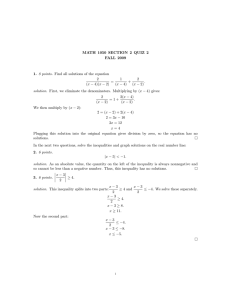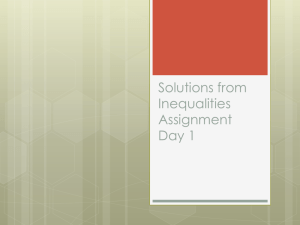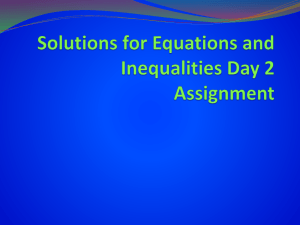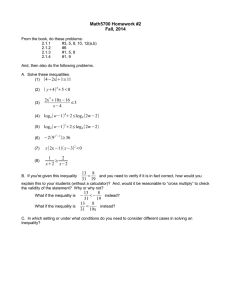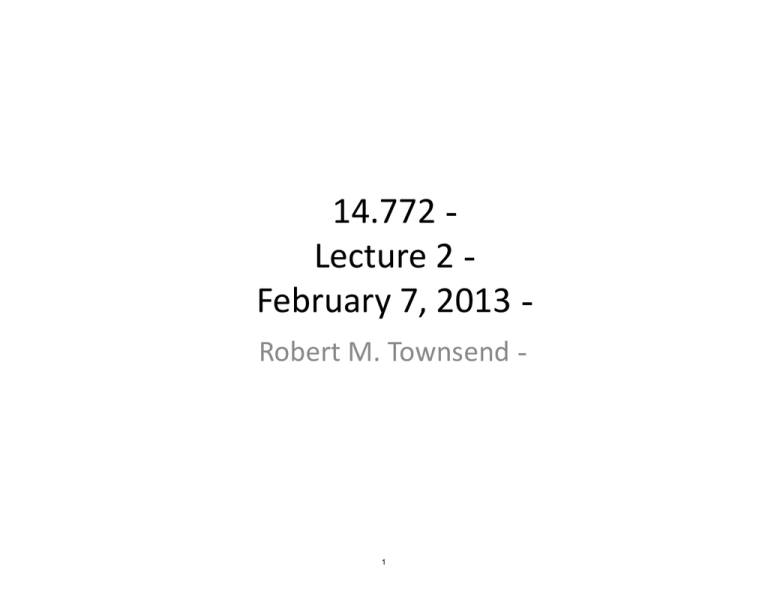
14.772
­
Lecture 2
­
February 7, 2013
­
Robert M. Townsend
­
1
Micro Founded Macro Models
­
Theoretical models tell well articulated, plausible stories of the impact of the financial
sector on growth, inequality, poverty. But how do we know that these models match up
to reality and can thus help us in the formulation of policy?
This lecture shows how to estimate the key financial economic underpinnings of two
well known, pre-existing models in the literature. The case study is Thailand but we
extend this local within-country data and to data from other countries.
We do this by fitting micro economic data to the choices that households and
businesses make, thus delivering a subset of the key parameters. The remaining
parameters are calibrated at plausible values, but typically using only subsets of the
data, as with initial conditions. Then the model at all these imposed parameter values is
simulated over time, and predicted paths of macro aggregates are compared to actual
time paths in the data. Macro aggregates include growth, inequality, income, savings
rates, and labor share of GDP, as well as key parts of each model, that is, the fraction of
households running business or the fraction of households participating in the financial
sector. Financial deepening is exogenous, imposed at observed values in one model,
and endogenous, a key choice in the other.
2
Micro Founded Macro Models (cont.)
­
Each model lends itself to a quantification of the welfare gains from a policy intervention. In the model
with an exogenous expansion of the financial sector, we can measure impact on winners as well as
losers, as households may or may not shift occupations as access to credit and savings increases, and
even when they do not shift, there are changes in investment on the intensive margin. The impact of
financial deepening depends as well on endogenous wages and interest rates; eventually increasing
wages have a huge impact on the relatively poor who do not start businesses but work for others. In the
model with endogenous financial deepening, a government takeover of the banking system creates an
inefficiency wedge which is associated with a clearly evident stagnation in growth rates. The welfare loses
from this repression, and conversely the welfare gains from subsequent financial liberalization are
quantified using the lens of the model.
Though welfare gains as a fraction of wealth from financial liberalization can be quite large, the impact on
subsequent growth can be small, if not negligible, as growth depends on the endogenous expansion of
the financial system, which depends on investment in costly infrastructure. Likewise, time series and
panel data generated from the model offer a stark warning that running cross-country regressions to
assess the impact of finance on growth and inequality is treacherous if the data come from actual
economies in transitions (not yet in steady state).
The larger theme here, however, is not to promote these two models as the end of the story, but rather
to promote the method of analytic attack. The models are relatively successful in Thailand, but fit less
well in Mexico, especially during a devaluation and sudden stop. As it turns out, that outcome was
predictable from the first step, from the ability the assumed key ingredients to fit the micro data. Indeed,
one can take each of the models to local, village and regional data within Thailand, and deduce that the
occupation choice model is reasonably successful, but the financial depending model does not take into
the account the contrasting behavior of government vs. private sector financial service providers. The
lecture ends with a comparison of the successes and failures of each model, hence directions for further
research. Ultimately policy recommendations vary from one model to the next so it is important to find
one that is approximately correct in both its micro and macro aspects.
3
“Growth and Inequality: Model Evaluation Based on an Estimation-
Calibration Strategy” Jeong & Townsend, 2003
­
..."
4
Empirical Observations on M exico and Thailand
Calibration
DSGE with Financial Sector
New mo dels
Static Applied General Equilibrium: Dual Sector Model
Bernhardt and Lloyed-Ellis ( Restud 2000) and Gine and Townsend
(2004)
Occupational choice: Farmers, Workers and Entrepreneurs
Given distribution of talent, i.e. Öxed-cost of openning a Örm H (x )
over (0, 1), distribution of inherited wealth G (b )
Farmers: W = g + b
Workers: W = w v + b
Entrepeneurs:
W = max0 l and 0 k b x ff (k, l ) wl (k + x )g + b
A person with inherited wealth b and talent x chooses her profession
to maximize W : w > w = v + g then no one will be farmer. If
x x e (b, w ) then she will become an entrepeneur, otherwise she
will become a worker.
5
Empirical Observations on M exico and Thailand
Calibration
DSGE with Financial Sector
New mo dels
Static Applied General Equilibrium: Dual Sector Model
Transition
Courtesy of Elsevier, Inc., http://www.sciencedirect.com. Used with permission.
General equilibrium:
R
E (w ) = H (x e (b, w )) G (db ) and
R R x e (b,w )
l (b, x, w ) H (dx ) G (db )
L (w ) =
0
E (w ) + L (w ) 1 with equality if w > w .
6
LEB Model
Model Economy
For the rest of the article please visit: "Growth and Inequality: Model Evaluation Based on an Estimation-Calibration Strategy." by Hyeok Jeong
and Robert M. Townsend. http://www.ncbi.nlm.nih.gov/pmc/articles/PMC2864508/#
7
Empirical Observations on M exico and Thailand
Calibration
DSGE with Financial Sector
New mo dels
Transitions
Bernhardt and Llloyed-Ellis: Rudimentary Dynamics
Given W each person solves maxC +B W U (C , B ) this gives the
bequest function B (W )
Gt (b ) =) wt =) Gt +1 (b )
The phases of economic development
Phase 1 (the Dual Economy, 0 t t 1 ) Wages remain at w .
Incomes and wealths grow in the Örst-order stochastic sense.
Phase 2 (the Transition, t 1 t t 2 ) Wages begin to rise, but
income and wealths continue to grow in the Örst-order stochastic
sense.
Phase 3 (Advanced Economic Development, t t 2 ) Wages rise, and
incomes and wealths grow in the second-order stochastic sense.
Phase 4 (Long Run) Wages converge and the distribution of incomes
and wealths converage to unique limitting distributions which are
independent of the initial distribution.
8
Empirical Observations on M exico and Thailand
Calibration
DSGE with Financial Sector
Incorporate Financial Sector
Gine and Townsend (2004)
New mo dels
A fraction a of people have access to borrowing and lending,
equilibrium interest rate R
Farmers: W = g + Rb
Workers: W = w v + Rb
Entrepeneurs:
W = max0 l and 0 k ff (k, l ) wl R (k + x )g + Rb
If x e
x (R, w ) then she will become an entrepeneur, otherwise she
will become a worker.
General equilibrium (w , R ) are such that
S (w , R ) = ab and
R R xe(R ,w )
D(w , R ) =R a
(k (R, w ) + x ) H (dxR) G1 (db )
0
E (w ) = a H (e
x (R, w )) G1 (db ) + (1 a) H (x e (b, w )) G2 (db )
R R xe(R ,w )
and L (w ) = a
l (R, w ) H (dx ) G1 (db ) +
0
R R x e (b,w )
l (b, x, w ) H (dx ) G2 (db )
(1 a )
0
D (w , R ) S (w , R ) with equality if R > 1
E (w ) + L (w ) 1 with equality if w > w
9
Empirical Observations on Mexico and Thailand
Calibration
DSGE with Financial Sector
Policy Impact
Gine and Townsend (2004) Thailand
INTERMEDIATION IMPACTS GROW TH , INTERMEDIATION, INEQUALITY, POVERTY, # FIRMS
Macro simulation:
Credit Matters
Eventual diminishing
Returns, BUT WE GET
TFP
Investment will move
too
Dynamics due to
improved
intermediation
η = .026, ω = .321, γ gr = 0
[Intermediated Model (SES Data). Notes:
. Source: Giné and Townsend (2004)]
Courtesy of Elsevier, Inc., http://www.sciencedirect.com. Used with permission.
10
New models
Empirical Observations on Mexico and Thailand
Calibration
DSGE with Financial Sector
Gine and Townsend (2004) Thailand
DISTRIBUTION OF GAINS
Policy Evaluation
Gains depend on
wealth and talent-
need disb of each-
Rich hh sensitive to
Interest rate,
occupation choice
Not talented rich
give up firms and
save
Change in talent will
change impact
Poverty Reduction:
Laudable Goal
Here it is
Linked to macro
growth
Courtesy of Elsevier, Inc., http://www.sciencedirect.com. Used with permission.
[Welfare Comparison in 1979 (Townsend Thai data) Source: Giné and Townsend (2004)]
11
New models
F igu r e 7.6.2.2 D a t a a nd model-p r ed icted a ver age en t r ep r eneu rsh ip levels, 2000-2008
(met r ic #2)
Source: Own calculations, ENOE/ENEU
Once again, the model predicts a higher entrepreneurship rate for the sector of the economy
without credit. The entrepreneurship rate for this sector dies not vary substantially, whereas the
entrepreneurship rate for the credit-enabled sector does vary a great deal, and again, increases
noticeably in 2005.
12
13
F igu r e 7.6.2.3 M odel-p r ed icted en t r ep r eneu rsh ip levels in cred it- a nd non-cred it secto rs,
2000-2008 (met r ic #2)
Source: Own calculations, ENOE/ENEU
14
Empirical Observations on Mexico and Thailand
Calibration
DSGE with Financial Sector
Transition
DSGE: Greenwood-Jovanovic (JPE 1990)
© University of Chicago Press. All rights reserved. This content is excluded from our
Creative Commons license. For more information, see http://ocw.mit.edu/fairuse.
15
New models
Empirical Observations on M exico and Thailand
Calibration
DSGE with Financial Sector
New mo dels
DSGE: Greenwood-Jovanovic (JPE 1990)
A model of Önancial participation
Household j maximizes
E0
"
j
t
b
ln
c
Â
t
•
t =0
#
with three investment choices
Riskless: it 1 at the end of period t 1 yields
period t
dit 1 in
Risky: it 1 at the end of period t 1 yields q t + ejt
it 1 in period
t
Financial intermediary: it 1 at the end of period t 1 yields
r (q t ) it 1 in period t, Öxed-fee q
Zero-proÖt condition for Önancial intermediaries implies
r (q t )
q
= g max (d, q t )
= a
16
Empirical Observations on M exico and Thailand
Calibration
DSGE with Financial Sector
New mo dels
DSGE: Greenwood-Jovanovic (JPE 1990)
Value function of individual i
Z
W (kt ) = max ln (kt st ) + b max fVNP,VPg dF (q t +1 ) dG ejt +1
st ,ft
VNP = W st ft q t +1 + ejt +1 + (1 ft ) d
j
VP = V st ft q t +1 + et +1 + (1 ft ) d q
and V (kt ) =
R
maxst ln (kt st ) + b max fW (st r (q t +1 )) , V (st r (q t +1 ))g dF (q t +1 )
Equilibrium: Set of value functions v (kt ) , w (kt ), saving rules,
s (kt ) and f (kt ) such that
choose to whether or not remain in the Önancial market
V (kt ) ? W (kt )
choose to whether or not to stay indepedent W (kt ) ? V (kt q )
17
Empirical Observations on Mexico and Thailand
Calibration
DSGE with Financial Sector
Townsend and Ueda (Restud 2007)
© International Monetary Fund. All rights reserved. This content is excluded from our
Creative Commons license. For more information, see http://ocw.mit.edu/fairuse.
18
New models
Empirical Observations on Mexico and Thailand
Calibration
DSGE with Financial Sector
Townsend and Ueda (Restud 2007)
© International Monetary Fund. All rights reserved. This content is excluded from our
Creative Commons license. For more information, see http://ocw.mit.edu/fairuse.
19
New models
GJ Model
Model Economy
Courtesy of Hyeok Jeong and Robert Townsend. Used with permission.
20
Estimation
Likelihood Function
Courtesy of Hyeok Jeong and Robert Townsend. Used with permission.
21
Estimation, cont.
­
Courtesy of Hyeok Jeong and Robert Townsend. Used with permission.
22
Estimation, cont.
­
Courtesy of Hyeok Jeong and Robert Townsend. Used with permission.
23
Empirical Observations on Mexico and Thailand
Calibration
DSGE with Financial Sector
Townsend and Ueda (Restud 2007)
[Benchm ark, best-fit (left-hand graphs) and H igher
V ariance, best-fit (right-hand graphs). Source:
T ow nsend and U eda (2005)]
© Reivew of Economic Studies, Ltd. All rights reserved. This content is excluded from our
Creative Commons license. For more information, see http://ocw.mit.edu/fairuse.
24
New models
Townsend & Ueda (2010) “Welfare Gains from Financial Liberalization,” IER
© International Monetary Fund. All rights reserved. This content is excluded from our
Creative Commons license. For more information, see http://ocw.mit.edu/fairuse.
25
Townsend & Ueda, IMF WP/03/193, 2003
­
© International Monetary Fund. All rights reserved. This content is excluded from our
Creative Commons license. For more information, see http://ocw.mit.edu/fairuse.
26
Townsend & Ueda, IER, 2010
­
© International Monetary Fund. All rights reserved. This content is excluded from our
Creative Commons license. For more information, see http://ocw.mit.edu/fairuse.
27
Empirical Observations on Mexico and Thailand
Calibration
DSGE with Financial Sector
Mexico: GDP Growth, 1989-2006
28
New models
Empirical Observations on Mexico and Thailand
Calibration
DSGE with Financial Sector
Mexico: Financial Participation, 1989-2006
29
New models
Empirical Observations on Mexico and Thailand
Calibration
DSGE with Financial Sector
Mexico: Change in Inequality, 1989-2006
30
New models
Felkner, John and Robert M. Townsend (2009)
“The Geographic Concentration of Enterprise
in Developing Countries,” Working Paper,
University of Chicago.
31
32
Courtesy of John S. Felkner and Robert M. Townsend. CC BY-NC-SA
33
Courtesy of John S. Felkner and Robert M. Townsend. CC BY-NC-SA
Figure 3
Courtesy of John S. Felkner and Robert M. Townsend. CC BY-NC-SA
34
ENTERPRISE CONCENTRATION
1986-1996
TAMBON DISTRICT LEVEL
(6500 TAMBONS)
Bivariate LISA Map:
1986 Enterprise in Relation to
Enterprise Growth 1986-1996
In Spatial Neigbhors
Clusters Significant at P < .05 Level
Corresponding Moran Scatterplot
Bins Mapped
Bivariate LISA Map:
1986 Enterprise in Relation to
Enterprise Growth 1986-1996
In Spatial Neigbhors
Legend
Major Roads
AREAS WHERE ENTERPRISE IS CONCENTRATING
NEW ENTERPRISE CONCENTRATIONS
LOW ENTERPRISE AREAS
AREAS LOSING ENTERPRISE
Figure 4
35
Courtesy of John S. Felkner and Robert M. Townsend. CC BY-NC-SA
0
90
180
"
Kilometers
360
ENTERPRISE CONCENTRATION 1986-1996
BIVARIATE LISA MAP
STATISTICALLY SIGNIFICANT
CONCENTRATIONS (P < .1)
Map is an output from a bivariate
Local Moran Index for 1532 villages,
considering 1986 fraction in enterprise surrounded
by 1986-1996 growth in fraction in enterprise
"
REDS are village with higher
than average enterprise in 1986,
surrounded by villages with higher than
average growth in enteprise 1986-1996
PINKS are villages with lower
than average enteprise in 1986,
surrounded by villages with higher than
average enterprise growth 1986-1996
Legend
DARK BLUES are villages with lower than
AREAS WHERE ENTERPRISE IS CONTINUING TO CONCENTRATE average enterprise in 1986, surrounded by
villages with lower than average enterprise
growth 1986-1996
NEW ENTERPRISE CONCENTRATIONS ARISING
LOW ENTERPRISE AREAS
AREAS LOSING ENTEPRISE
Major Roads
Figure 6
36
LIGHT BLUES are villages with higher than
average enterprise in 1986, surrounded by
villages with lower than average enterprise
growth 1986-1996
Courtesy of John S. Felkner and Robert M. Townsend. CC BY-NC-SA
Primary Estimation:
Occupational Choice Structural Simulation
Spatial Model:
M Parameter Varies Across Space
Bivariate LISA Map 1986-1996
"
0 10 20
ENTERPRISE CONCENTRATION
1986-1996
STATISTICALLY SIGNIFICANT
CONCENTRATIONS
(P = .1 OR LESS)
Map is an output from a bivariate
Local Moran Index for 1532 villages,
considering 1986 fraction in enterprise surrounded
by 1986-1996 growth in fraction in enterprise
REDS are village with higher
than average enterprise in 1986,
surrounded by villages with higher than
average growth in enteprise 1986-1996
PINKS are villages with lower
than average enteprise in 1986,
surrounded by villages with higher than
average enterprise growth 1986-1996
Kilometers
40
Legend
DARK BLUES are villages with lower than
AREAS WHERE ENTERPRISE IS CONTINUING TO CONCENTRATE average enterprise in 1986, surrounded by
villages with lower than average enterprise
growth 1986-1996
NEW ENTERPRISE CONCENTRATIONS ARISING
LOW ENTERPRISE AREAS
AREAS LOSING ENTERPRISE
Major Roads
Figure 10
37
LIGHT BLUES are villages with higher than
average enterprise in 1986, surrounded by
villages with lower than average enterprise
growth 1986-1996
Courtesy of John S. Felkner and Robert M. Townsend. CC BY-NC-SA
Courtesy of John S. Felkner and Robert M. Townsend. CC BY-NC-SA
Figure 7
38
Figure 13
­
39
Courtesy of John S. Felkner and Robert M. Townsend. CC BY-NC-SA
“Growth and Inequality: Model Evaluation Based on an Estimation-
Calibration Strategy” Jeong & Townsend, 2003
­
40
“Growth and Inequality: Model Evaluation Based on an Estimation-
Calibration Strategy” Jeong & Townsend, 2003
­
41
Jeong, Hyeok and Robert M. Townsend (2003)
“"Growth and Inequality: Model Evaluation
Based on an Estimation-Calibration Strategy,"
with Hyeok Jeong,” IEPR WP #5-10.
42
A.3
Summary Table
1. LEB
1.1. Aggregate Dynamics
Success
Trends and movements of income level
Movements of income growth rate
Inequality movements
Increasing population share of entrepreneurs
Direction of changes in population composition
Failure/Anomaly
Initial high growth
Lower inequality level overall
Lower level of population share of entrepreneurs
Population size ordering
(too few non-participant entrepreneurs
too many participant entrepreneurs)
Higher fraction of entrepreneurs in the nancial
sector
Financial expansion onto growth
(especially the upturn of late 1980Ws)
1.2. Subgroup Dynamics
Success
Income of non-participant workers increases
(though less than in the data)
Failure/Anomaly
Incomes of all three other categories decrease
Missing co-movements of growth rates
across occupation groups before 1992
Gap is too large
Non-participant entrepreneurs earn higher income
than participant entrepreneurs
Missing the surge of income of participant
entrepreneurs in late 80Ws and subsequent increase
of income of non-participant entrepreneurs
Subgroup inequality levels are too low
Higher inequality among participants
than non-participants
Inequality among participants decreases
Missing divergence between participant and
non-participant groups
Fail to relate movements of aggregate income
growth and inequality to growth patterns of the
richest group, the participant entrepreneurs
Capturing occupational income gap
1.3. Decomposition
Success
Capturing compositional eects on growth
and inequality change
Signs of all eects on inequality change are right
(Increase in subgroup inequality and
decrease in income gap via convergence)
Adding nancial expansion helps decomposition
eects to be closer to data
Failure/Anomaly
Too large orders of magnitude
Too large orders of magnitude
(Due to too large occupational income gap)
But not good enough and exogenous addition
of nancial sector creates other anomalies
© University of Southern California. This content is excluded from our Creative
Commons license. For more information, see http://ocw.mit.edu/fairuse.
42
43
1.4. Shape of Income Distribution
Success
Failure/Anomaly
Fail to predict overall shape of income
distribution
Spike at the low end hence missing income
variation among the poor
Missing the extremely rich
2. GJ
1.1. Aggregate Dynamics
Success
Trend and level of average income
Failure/Anomaly
Not capturing movements
(stagnation and then upturn after 1986)
Not capturing movements (downturn after 1992)
and over-predicts the increase
Missing nonlinear pattern of expansion
(surge after 1986)
Trend and level of inequality
Trend and level of nancial expansion
1.2. Subgroup Dynamics
Success
Average income of participants increases
Failure/Anomaly
Average income of non-participants stays constant
Missing co-movement of growth rates before 1992
Gap is too large
Income gap between participants and
non-participants (LEB anomaly solved)
Higher growth rates of participants than
non-participants, hence diverging income
levels between them (LEB anomaly solved)
Missing catch-up of non-participants after 1992
Inequality within participants increases
(LEB anomaly solved)
Too low subgroup inequality
Fail to relate movements of aggregate patterns of
growth and inequality to the growth patterns of
the richest group, participant entrepreneurs
1.3. Decomposition
Success
Capturing compositional eects on growth
and inequality change
Signs of across-group inequality eects are right
Failure/Anomaly
Too large orders of magnitude
Wrong signs of within-group inequality eects
Too large across-group inequality
1.4. Shape of Income Distribution
Success
Overall shape of income distribution
Failure/Anomaly
Missing middle class
Over-predicting poverty
Missing the extremely rich
© University of Southern California. This content is excluded from our Creative
Commons license. For more information, see http://ocw.mit.edu/fairuse.
43
44
MIT OpenCourseWare
http://ocw.mit.edu
14.772 Development Economics: Macroeconomics
Spring 2013
For information about citing these materials or our Terms of Use, visit: http://ocw.mit.edu/terms.


